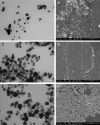Synthesis of antimicrobial silver nanoparticles through a photomediated reaction in an aqueous environment
- PMID: 26855570
- PMCID: PMC4725629
- DOI: 10.2147/IJN.S93611
Synthesis of antimicrobial silver nanoparticles through a photomediated reaction in an aqueous environment
Abstract
A fast, economical, and reproducible method for nanoparticle synthesis has been developed in our laboratory. The reaction is performed in an aqueous environment and utilizes light emitted by commercially available 1 W light-emitting diodes (λ =420 nm) as the catalyst. This method does not require nanoparticle seeds or toxic chemicals. The irradiation process is carried out for a period of up to 10 minutes, significantly reducing the time required for synthesis as well as environmental impact. By modulating various reaction parameters silver nanoparticles were obtained, which were predominantly either spherical or cubic. The produced nanoparticles demonstrated strong antimicrobial activity toward the examined bacterial strains. Additionally, testing the effect of silver nanoparticles on the human keratinocyte cell line and human peripheral blood mononuclear cells revealed that their cytotoxicity may be limited by modulating the employed concentrations of nanoparticles.
Keywords: antimicrobial activity; green synthesis; nanocubes; nanospheres.
Figures






Similar articles
-
Lysozyme catalyzes the formation of antimicrobial silver nanoparticles.ACS Nano. 2009 Apr 28;3(4):984-94. doi: 10.1021/nn900079e. ACS Nano. 2009. PMID: 19344124
-
Fabrication of pure and moxifloxacin functionalized silver oxide nanoparticles for photocatalytic and antimicrobial activity.J Photochem Photobiol B. 2018 Sep;186:116-124. doi: 10.1016/j.jphotobiol.2018.07.011. Epub 2018 Jul 17. J Photochem Photobiol B. 2018. PMID: 30036828
-
Synthesis and characterization of silver nanoparticles using Caesalpinia pulcherrima flower extract and assessment of their in vitro antimicrobial, antioxidant, cytotoxic, and genotoxic activities.Artif Cells Nanomed Biotechnol. 2017 Dec;45(8):1556-1567. doi: 10.1080/21691401.2016.1261871. Epub 2016 Nov 30. Artif Cells Nanomed Biotechnol. 2017. PMID: 27900878
-
Cell type-specific responses of peripheral blood mononuclear cells to silver nanoparticles.Acta Biomater. 2011 Sep;7(9):3505-14. doi: 10.1016/j.actbio.2011.05.030. Epub 2011 May 27. Acta Biomater. 2011. PMID: 21651999
-
Handling (Nano)Silver as Antimicrobial Agent: Therapeutic Window, Dissolution Dynamics, Detection Methods and Molecular Interactions.Chemistry. 2020 Aug 26;26(48):10948-10971. doi: 10.1002/chem.202002143. Epub 2020 Aug 7. Chemistry. 2020. PMID: 32687620 Review.
Cited by
-
Synergistic and antibiofilm potential of Curcuma aromatica derived silver nanoparticles in combination with antibiotics against multidrug-resistant pathogens.Front Chem. 2022 Nov 9;10:1029056. doi: 10.3389/fchem.2022.1029056. eCollection 2022. Front Chem. 2022. PMID: 36438875 Free PMC article.
-
Biological and Physicochemical Assessment of Middle Ear Prosthesis.Polymers (Basel). 2019 Jan 6;11(1):79. doi: 10.3390/polym11010079. Polymers (Basel). 2019. PMID: 30960063 Free PMC article.
-
Biocompatible Nanocomposite Implant with Silver Nanoparticles for Otology-In Vivo Evaluation.Nanomaterials (Basel). 2018 Sep 27;8(10):764. doi: 10.3390/nano8100764. Nanomaterials (Basel). 2018. PMID: 30262741 Free PMC article.
-
Implementation of green-assessed nanotechnology and quality by design approach for development of optical sensor for determination of tobramycin in ophthalmic formulations and spiked human plasma.BMC Chem. 2024 Jul 15;18(1):131. doi: 10.1186/s13065-024-01234-y. BMC Chem. 2024. PMID: 39010206 Free PMC article.
-
A review of drug delivery systems based on nanotechnology and green chemistry: green nanomedicine.Int J Nanomedicine. 2017 Apr 12;12:2957-2978. doi: 10.2147/IJN.S127683. eCollection 2017. Int J Nanomedicine. 2017. PMID: 28442906 Free PMC article. Review.
References
-
- Kim J, Kuk E, Yu K, et al. Antimicrobial effects of silver nanoparticles. Nanomedicine. 2007;3:95–101. - PubMed
-
- Rai M, Deshmukh S, Ingle A, Gade A. A silver nanoparticles: the powerful nanoweapon against multidrug-resistant bacteria. J Appl Microbiol. 2012;112:841–852. - PubMed
-
- Yin Y, Liu J, Jiang G. Sunlight-induced reduction of ionic Ag and Au to metallic nanoparticles by dissolved organic matter. ACS Nano. 2012;6:7910–7919. - PubMed
-
- Wiley B, Herricks T, Sun Y, Xia Y. Polyol synthesis of silver nanoparticles: use of chloride and oxygen to promote the formation of single-crystal, truncated cubes and tetrahedrons. Nano Lett. 2004;4:1733–1739.
-
- Byeon J, Kim Y. A novel polyol method to synthesize colloidal silver nanoparticles by ultrasonic irradiation. Ultrasonics Sonochem. 2012;19:209–215. - PubMed
Publication types
MeSH terms
Substances
LinkOut - more resources
Full Text Sources
Other Literature Sources

